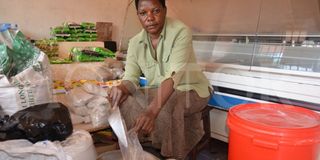Prime
High commodity prices push Uganda’s inflation to 3.2% - UBOS

A woman measures sugar in her retail shop on main street in Jinja City. PHOTO/TAUSI NAKATO
What you need to know:
- Analysis by geographical areas and income groups, reveals that Gulu registered the highest inflation of 4.4 percent but slightly down from 4.5 percent registered in January 2022.
- The least inflation was registered in Jinja at 1.6 percent for the last 12 months to February 2022 the same rate recorded in January 2022.
The steady increase in prices of commodities and services over the last 12 months, ending February 2022 has pushed Uganda's inflation to 3.2 percent up from 2.7 percent registered in January.
The increase in prices of goods and services implies that the general population in the country was forced to adjust their budget to access goods and services, according to Uganda Bureau of Statistics (UBOS).
Presenting the Consumer Price Index (CPI) in Kampala on February 28, UBOS principal statistician price index, Mr Edgar Niyimpa said: “ The rise in inflation was driven by the increase in prices of commodities under; education services that increased by 9 percent, furnishings, household equipment and routine households that went up by 9 percent.”
Mr Niyimpa said during the same period, restaurants and accommodations services went up by 3.2 percent, clothing and footwear by 2.5 percent, transport by 0.6 percent, personal care, social protection and miscellaneous goods by 4.6 percent.
He said during the same period the core inflation, which excludes volatile commodities in the consumer price basket, for the 12 months to February 2022 increased to 3.1 percent, up from 2.3 percent registered in January 2022. This is mainly attributed to annual Other Goods Inflation that increased to 5.1 percent for the 12 months to February 2022 up from 4.3 percent in January 20022.
The other goods in this context are soap, education services among others.
In addition, Uganda Bureau of Statistics said annual services inflation increased to 0.8 percent for the 12 months up from 0.0 percent recorded in January 2022 indicating the charges are slowly increasing.
The Non-Core Inflation for the last 12 months to February 2022 decreased to 3.5 percent, down from 5.0 percent in January 2022. The decrease in annual No-Core inflation is attributed to food crops and related items’ inflation which increased to 0.7 percent in February 2022, down from 3.7 percent in January 2022.
This was due to annual vegetables, tubers, plantains, cooking bananas and pulse inflation that registered 0.0 percent in February 2022, down from 5.1 percent registered in January 2022.
However, UBOS said annual Energy Fuel and Utilities Inflation (EFU) increased to 7.0 percent, up from 6.5 percent in January 2022.
Mr Niyimpa explained that the increase in EFU Inflation was due to annual Liquid Energy fuels that increased to 25.2 percent in February 2022 up from 22.6 percent in January.
"Specifically, annual petrol inflation increased to 34.0 percent in February 2022 up from 30.5 percent registered in January 2022," he said.
Analysis by geographical areas and income groups, reveals that Gulu registered the highest inflation of 4.4 percent but slightly down from 4.5 percent registered in January 2022.
This was driven by annual furnishing house equipment and routine household inflation that increased to 15.4 percent in February up from 7.3 percent registered in January 2022. This means that prices of these items remained high during the period.
The second highest inflation was registered in Kampala High Income at 4.2 percent up from 3.1 percent recorded in January 2022. This was driven by annual Education services inflation that increased to 12 .1 percent in February 2022 up from 0.6 percent registered in January 2022.
The least inflation was registered in Jinja at 1.6 percent for the last 12 months to February 2022 the same rate recorded in January 2022.
READ MORE:




